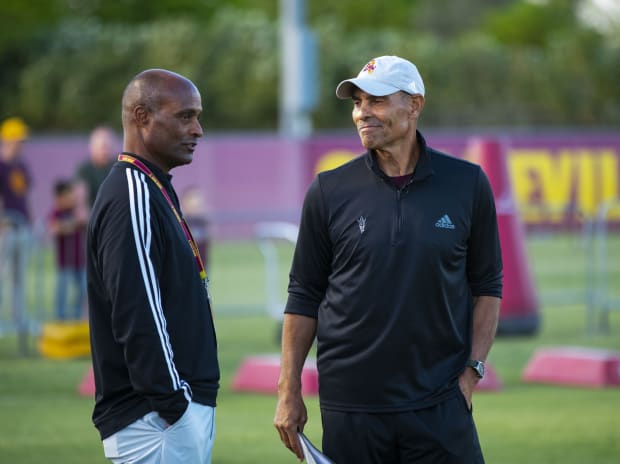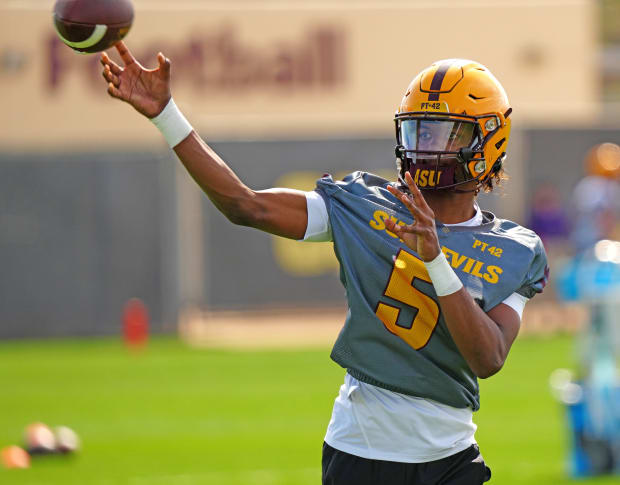When surveying the six-year festival of dysfunction that has enveloped Arizona State football, it’s tempting to start with this latest act, in which the school nukes itself with a bowl ban five days before the season opener. That news was delivered Sunday morning to an unsuspecting team, and it comes at a time when the NCAA is all but eliminating postseason bans.
But we’ll get to that stunning and suspicious decision in a few paragraphs. First, let’s review this theater of the absurd one act at a time, to see how it reached a clownish climax Sunday. Let’s begin when a onetime agent and his former client went into business together.
On Dec. 3, 2017, athletic director Ray Anderson (the onetime agent) hired Herm Edwards (his former client) to be the Sun Devils’ football coach at the spritely age of 63. The weird move was poorly received at the time—and, after some moderate early success, we can now say, in hindsight, that it was a raging disaster.

Mark J. Rebilas/USA TODAY Sports
Edwards was hired out of the ESPN studios after eight years away from coaching, and he hadn’t worked at the college level since 1989. He assuredly didn’t know anything about NCAA rules, and either didn’t care to learn or simply ignored them. Twenty days into the job, Edwards hired former NFL linebacker Antonio Pierce, who had never coached in college. Edwards named Pierce recruiting director in September 2018, and it wouldn’t be long before Jeremy Pruitt’s Tennessee program had a serious rival in reported rule breaking.
Media reports identified Pierce as helping foster a culture of complete disregard for NCAA bylaws. The most notable scofflaw behavior: arranging and paying for dozens of impermissible campus visits during the COVID-19 dead period. That provided a clear competitive advantage at a time when public health and safety should have been prioritized.
By June 2021, there were multiple media reports that an NCAA investigation was underway at Arizona State. A person or group with firsthand knowledge of the alleged violations sent documentation to the NCAA and to ASU administrators. This was a smoking gun that reportedly implicated as many as five assistant coaches and Edwards.
Yet ASU’s response was hardly aggressive. Some staffers were placed on administrative leave, while Edwards and Pierce kept their jobs. After a 7–5 regular season in 2021, Edwards rather incredibly announced that he would still be the coach the following year. Pierce wound up resigning on national signing day in February ’22, after ASU’s recruiting efforts had completely fallen apart.
With transfers fleeing the program en masse, Edwards staggered into the 2022 campaign and lasted three games. Anderson finally fired his buddy after a home loss to Eastern Michigan got the Devils off to a 1–2 start. The rest of the season was a forced march to 3–9, with the school administering its own recruiting restrictions. The year ended on a hopeful note, though, with Anderson hiring 32-year-old Oregon offensive coordinator Kenny Dillingham, an Arizona State grad.
That hiring was a potential coup, especially when elite quarterback recruit Jaden Rashada signed on with the Devils, ultimately winning the starting job for the opener against Southern Utah Thursday night. Then, amid hopes that a retooled team might be able to pull out a .500 season, the school swung open the trap door beneath Dillingham, Rashada and the rest of the team Sunday.

Patrick Breen/The Republic/USA TODAY Network
ASU’s self-imposed ban comes 44 days after the NCAA Committee on Infractions rather openly declared that it no longer wants to take away postseason competition from schools that break the rules—even blatantly and in bulk. The COI hit Tennessee with about $9 million in fines and hammered the involved coaches in a case it declared “one of the worst the COI has seen.” But it refused to invoke a bowl ban, despite it being prescribed within the NCAA bylaws for the level of violations the school committed.
Here is what Chief Hearing Officer Kay Norton wrote in the ruling on Tennessee: “This case came to the COI at a time of great change for the Association. Changes to the infractions process began roughly two years ago with the adoption of a new NCAA Constitution, which in relevant part states, ‘Divisional and, as appropriate, conference regulations must ensure to the greatest extent possible that penalties imposed for infractions do not punish programs or student-athletes not involved nor implicated in the infractions.’”
In this climate, Arizona State self-imposing a bowl ban is like someone requesting a speeding ticket from a state trooper who is idly watching everyone drive 80 mph in a 55. So what exactly is going on here? A few theories:
*The full scope of the case is spectacularly bad, even worse than Tennessee’s, thus opening up the possibility for bigger sanctions than what the Volunteers got. Since ASU clearly did not take immediate corrective action of its own by firing Edwards and Pierce the way Tennessee did by canning Pruitt and his staff, the school has to do something to try to soften the hammer blow when it falls.
- Arizona State is pleading poverty. Backed by Southeastern Conference revenue, a deep roster of donors and ticket revenue from a 100,000-seat stadium, Tennessee can find the money to pay $9 million in fines. ASU might not have that money at its disposal.
- The Sun Devils got far enough into practice to figure out they’re not going to be very good, so they might as well take the ban for what could well turn out to be a losing season. (This is known as the Auburn Strategy. The school self-imposed a ban on its men’s basketball program just before the start of what would be a 13–14 season in 2020–21.)
The latter theory loses its legs, though, when considering how blindsided the current team was by the decision. A source tells Sports Illustrated that Dillingham was informed this morning, shortly before the team was told.
Dillingham had recruited dozens of new players to the program via high school and the transfer portal, which means a sizable percentage of the roster was not party to the alleged violations that occurred. These are exactly the kinds of players the NCAA is trying to avoid penalizing—yet the school went ahead and did it voluntarily.
Not only that, the timing here opens up the school to accusations of dealing with the players in bad faith. With school underway at Arizona State and most other universities, it’s a difficult time to transfer (an immediate-eligibility transfer should be available to the athletes, given the postseason ban). And with most programs starting competition this week, depth charts and playing rotations are largely set.
In other words, it’s fair to at least ask: Did the school time this decision to handcuff the players to the program for this season?
Maybe Anderson will get around to answering that question. He also needs to answer for hiring college know-nothing Herm Edwards in the first place, and for retaining him more than a year after this scandal first came to light.
Ultimately, Anderson himself needs to go, too. This festival of dysfunction still hasn’t run its full course, but the last clown at the center of it should be promptly herded off-stage.







